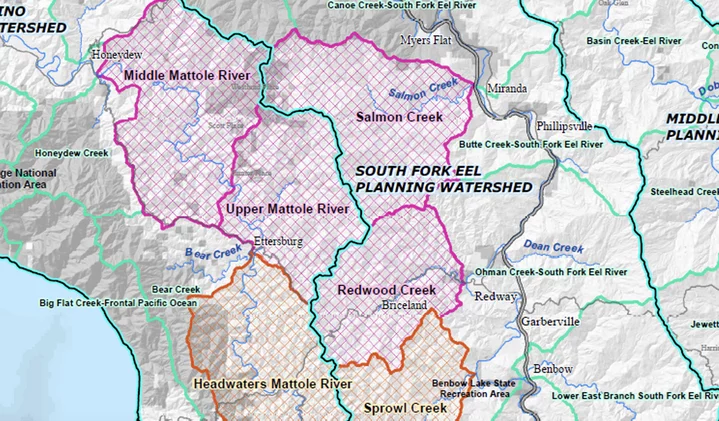Detail of a Humboldt County watershed planning map.
###
A trio of local environmental groups is accusing the county of abandoning its legal obligation to fully assess the impacts of the local cannabis industry on groundwater, wildfire risk, streams, rivers and more.
In a letter submitted yesterday to the Board of Supervisors, the Planning Commission and Planning and Building Director John Ford, leaders of the three groups – Northcoast Environmental Center, Citizens for a Sustainable Humboldt and the Environmental Protection Information Center – say the county must formally ask regulatory agencies to collect and report more data so that the county can comply with a resolution it passed nearly four years ago.
That resolution, No. 18-43, established watershed-specific caps on the number of permits and acres the county can approve for commercial cannabis cultivation, plus an overall cap of 3,500 permits and 1,205 acres. It says the county must conduct an annual review of those limits at noticed public meetings of the Board of Supervisors. Such hearings have never been held.
The letter says that the county, as the lead agency in charge of regulating the industry here in Humboldt, needs to request more information from state and federal agencies including the California State Water Resources Control Board, the California Department of Fish and Wildlife, the Bureau of Land Management and the U.S. Forest Service.
Without that data, the letter says, regulators lack “a robust understanding of the cumulative impacts of industrial cannabis cultivation in each watershed and sub-watershed.”
Asked via email to respond to the allegation that the county has failed to comply with Resolution No. 18-43, Ford offered a brief response that more or less confirmed that to be the case, though the reply implicates other agencies along with the county.
“There has not been adequate reporting as discussed in Resolution 18-43,” Ford wrote in an email.
Below is the full text of the letter, which was sent ahead of next week’s supes’ meeting, at which the board is expected to discuss related issues.
Re: Watershed Analysis / Data Collection & Reporting / Humboldt County Cannabis Ordinance 2.0
To the Humboldt County Board of Supervisors, Humboldt County Planning Commission, and Director Ford:
The County is not following its own Resolution 18-43 and FEIR.
We seek immediate action: the lead agency—the Humboldt County Planning Department—must formally request that watershed monitoring, data collection, and analyses be performed by the appropriate California State and Federal agencies. These include the State Water Board, NCRWQCB, CDFW, CDF, BLM and USFS.
Fulfillment of this request, with necessary reporting in combination with disclosure of data already collected by the County, shall allow for a robust understanding of the cumulative impacts of industrial cannabis cultivation in each watershed and subwatershed. It will make clear the true, on-the-ground environmental and community carrying capacities and parameters… and begin to realize the legal obligations and responsibilities committed to by the County, which have been abandoned.
This formal analysis will inform realistic environmental guidelines, regulations, and other policy, including that for permit allocation and enforcement. It should include:
- Data on roads and traffic, for accurate assessment of impacts to rural infrastructure, public safety, increased burden on first responders, and enhanced risk of wildfire.
- Data from watershed and subwatershed studies and analyses, including temporal monitoring data on stream flow and water quality (e.g. nutrients, temperature, bacteria, sediment, etc.).
- Data regarding impacts of groundwater extraction on surface waters, springs, and seeps.
- Data measuring the scope of industrial level noise and high wattage lights, to assess impacts on wildlife and communities.
- Detailed maps of permitted and pending permit sites—showing pending, active, and lapsed permit location—original and expanded cultivation areas and types, energy sources/generators, water sources/locations, streams and rivers, and roads.
This formal data collection and analysis must be accompanied by reporting at annual public hearings to assess and implement potential caps on cultivation acreage based on real information, as stated in the 2018 Resolution 18-43*…which have never occurred.
In addition to a formal request by the lead agency for this watershed monitoring and data collection, we urge you to develop a specific action plan for implementing its public availability and discussion.
Sincerely,
Larry Glass,
President of the Board of Directors
Northcoast Environmental Center (NEC)
(707) 822-6918
nec@yournec.orgMary Gaterud,
President of the Board of Directors
Citizens for a Sustainable Humboldt (CSH)
(707) 845-2199
marygaterud@gmail.comTom Wheeler,
Executive Director Environmental Protection Information Center (EPIC)
(707) 822-7711
epic@wildcalifornia.com*As per Resolution 18-43: “—analysis of the condition of these planning watersheds, including review of water flow data and applicable studies or information prepared by the following state and local agencies: California Department of Fish & Wildlife, North Coast Regional Water Quality Control Board, State Water Resources Control Board, and the Department of Forestry and Fire Protection…”
“Following the establishment of a countywide cap on the total number of permits and acreage of cultivation that may be approved, beginning in May of 2019, the Board of Supervisors agrees to conduct an annual review of the limits and prescribed distribution of permitting and acreage allowances found in the above table. Review shall occur at noticed public hearings held during a meeting of the Board Supervisors, during which the Board shall receive and consider a report providing an update on local permitting efforts.”
“—detailing the number and status of all applications received, permits approved, compliance agreements that have been executed, and code enforcement actions undertaken by the Department. Law enforcement or other relevant officials from local and state agencies shall be contacted and invited to provide and present input and information to be considered by the Board during annual review. After holding a public hearing and considering all information and testimony received, the Board may choose to establish new caps on acreage and permits as well as change their distribution within watersheds.”
###
DOCUMENT: Resolution No. 18-43

CLICK TO MANAGE